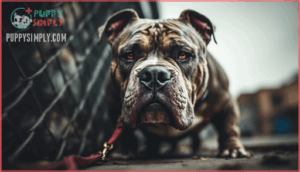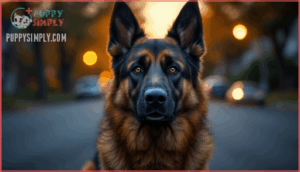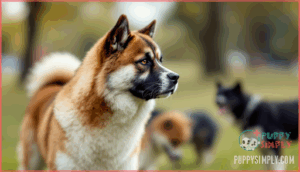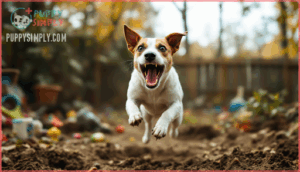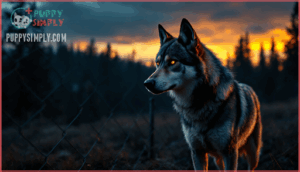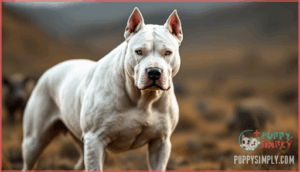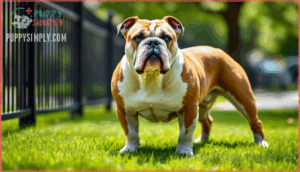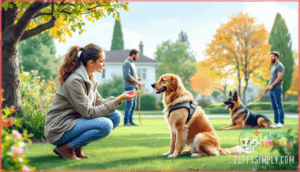This site is supported by our readers. We may earn a commission, at no cost to you, if you purchase through links.
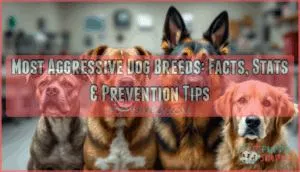
While certain breeds appear more frequently in bite statistics, the real story lives in the intersection of genetics, environment, pain, and learning history. Pit bulls and Rottweilers dominate headlines and insurance blacklists, but data reveals that aggression isn’t hardwired into any breed’s DNA—it’s inherited as a tendency, then shaped by everything from early weaning and aversive training to undiagnosed arthritis and chaotic households.
Understanding which breeds carry higher genetic risk for specific types of reactivity, and why those tendencies emerge, gives you the tools to prevent bites rather than simply fear dogs based on their silhouette.
Table Of Contents
- Key Takeaways
- Why Some Dog Breeds Show Aggression
- Common Traits of Aggressive Dog Breeds
- Breeds Most Often Linked to Aggression
- Dog Bite Statistics and Aggression Trends
- Preventing and Managing Dog Aggression
- Frequently Asked Questions (FAQs)
- Are mixed breed dogs as aggressive as purebreds?
- Can neutering reduce aggression in male dogs?
- What are signs of aggression in puppies?
- How can I find a dog trainer who specializes in aggression?
- Is it possible to train very aggressive dogs safely at home?
- Can aggressive dogs ever be fully rehabilitated?
- What insurance covers injuries from aggressive breeds?
- Are muzzles effective for managing aggressive dogs?
- How do rescue dogs differ in aggression levels?
- What legal consequences follow a dog attack incident?
- Conclusion
Key Takeaways
- Aggression isn’t hardwired into any breed’s DNA—it’s inherited as a genetic tendency (around 51% heritable) that’s then shaped by environment, training, pain, and learning history, meaning your choices as an owner matter more than the dog’s silhouette.
- Pit bulls dominate fatal attack statistics (roughly 67% of deaths in 2024) not because they’re inherently vicious, but because selective breeding for tenacity combined with their 235-250 PSI bite force creates unique risks when socialization, training, or pain management fails.
- Early socialization between 3-14 weeks, positive reinforcement training, and medical screening for chronic pain are the most effective prevention tools—dogs trained with reward-based methods show 55% less aggression than those subjected to confrontational techniques like alpha rolls.
- Breed-specific legislation has failed across 97 repealed U.S. municipalities because breed is a poor predictor of aggression compared to owner experience, household stress, and whether dogs receive consistent boundaries during their critical developmental window.
Why Some Dog Breeds Show Aggression
Aggression in dogs isn’t just about breed—it’s shaped by genetics, environment, training, and even health. Understanding why certain dogs show aggressive behavior helps you make smarter choices and prevent problems before they start. Let’s break down the main factors that influence canine aggression.
Genetics and Breed History
When you’re looking at dog breed genetics, you’ll find that aggression isn’t determined by a single gene. It’s polygenic, meaning multiple genes work together to shape behavior. Research shows heritability estimates for aggression sit around 51%, with breed-specific traits ranging between 60–70%. A recent study highlights the genetic basis of these behavioral differences.
Here’s what selective breeding has done:
- Guarding and fighting breeds like Pit Bulls were deliberately bred for protective instincts and tenacity
- Working lines versus show lines show measurable behavioral differences due to distinct breeding purposes
- Evolutionary context matters—domestication reduced fear but left defensive aggression as an adaptive trait
Gene-environment interaction explains why two dogs with similar genetics can behave completely differently depending on their upbringing and experiences.
Environmental and Social Factors
While genetics set the stage, a dog’s environment can worsen or suppress aggressive tendencies. Dogs living alone show more owner-directed aggression than those in multi-dog homes, while larger families correlate with increased reactivity—likely from overstimulation or resource competition. Early weaning before 8 weeks, household tension, and aversive training methods all increase risk. Urban living generally reduces stranger-directed aggression through repeated exposure, but isolation and high-noise environments create chronic stress. Owner experience matters enormously: first-time handlers face higher aggression rates because they miss subtle body language cues. Recent studies have shown that fearfulness is a factor that greatly contributes to aggressive behaviors.
| Factor | Increased Aggression Risk | Protective Effect |
|---|---|---|
| Household Structure | Single-pet homes, larger families | Multi-dog households |
| Owner Background | First-time owners, aversive training | Experienced handlers, positive reinforcement |
| Social Environment | Isolation, early weaning, household tension | Daily interaction, proper socialization window (7-16 weeks) |
Training and Socialization
How you train your dog matters more than the breed label on its paperwork. Positive reinforcement cuts adult aggression by over 50% compared to punishment-based methods, while confrontational techniques like alpha rolls trigger aggressive responses in 30% of dogs.
Early socialization before 16 weeks dramatically lowers fear and reactivity throughout life.
Guardian education is equally powerful: owners trained in reward-based approaches report 55% less aggression, proving that your knowledge shapes your dog’s behavior as much as genetics ever could.
Health and Medical Issues
Beyond training, chronic pain turns otherwise gentle dogs into reactive ones. Dogs with musculoskeletal pain show protective aggression toward certain body parts, while neurological disorders, hormonal imbalances, infections, and genetic contributors silently reshape behavior.
Canine health issues you can’t see might include:
- Osteoarthritis causing sudden snapping when touched
- Brain tumors altering impulse control overnight
- Low serotonin levels fueling defensive reactions
- Rabies or encephalitis triggering severe aggression
- Breed-linked rage syndrome producing unpredictable outbursts
Canine genetics and dog breed health profoundly influence behavior, making medical screening essential before labeling any dog "aggressive.
Common Traits of Aggressive Dog Breeds
Not all dogs with a reputation for aggression share the same traits, but certain physical and behavioral characteristics do appear more frequently in breeds linked to serious incidents.
Understanding these common patterns can help you recognize what makes some dogs more challenging to manage than others. Let’s look at the key traits that often show up in breeds most associated with aggressive behavior.
Physical Strength and Bite Force
When you’re measuring dog bite risk, bite force (PSI) is one piece of the puzzle—but it’s a critical one. A Kangal’s 743 PSI can fracture bones on contact, while breeds above 500 PSI cause tissue damage that complicates medical reconstruction.
Skull morphology and jaw musculature determine brute strength, and that directly impacts injury severity in dog bite incidents, where damage potential escalates quickly with physical power.
Protective and Territorial Instincts
When guard dogs defend territory, they’re following instincts carved into their DNA over centuries of selective breeding for livestock and property defense. Genetic predisposition shapes protective instincts, but environmental stressors—like confined spaces or frequent visitors—heighten territorial behavior by 23%.
Hormonal influence matters too; unneutered males show increased territorial aggression that drops 38% after neutering and behavior modification.
Owner experience is life-changing: novice handlers report 2.3 times more protective incidents than seasoned owners who understand mitigation strategies and early socialization.
Reactivity and Temperament
Reactivity genetics explain why some dogs reach fight-or-flight mode faster—breed-specific heritability for stranger-directed aggression climbs to 0.68. Stress responses matter: dogs stuck in high-arousal states show impaired cognitive control and 71% aggression risk with repeated triggers.
Social modulators like early socialization cut reactive behaviors by 60%. Temperament types vary—high-reactive, fearful dogs create "danger zone" profiles, while calm temperaments adapt better to families.
Understanding these aggression predictors helps you match canine temperament and breed characteristics to your lifestyle.
Breeds Most Often Linked to Aggression
When you look at bite statistics and behavioral reports, certain breeds appear more frequently than others. The reasons are complex—ranging from historical breeding purpose to physical capability—but the patterns are real enough to warrant attention.
Let’s walk through the breeds most often flagged for aggression, keeping in mind that any dog’s behavior depends heavily on training, socialization, and responsible ownership.
Pit Bull Types
Pit bull fatalities dominate Dog Bite Statistics, accounting for roughly 67% of fatal attacks in 2024 despite representing just 7% of the breed population. When you’re evaluating Aggressive Dog Breeds, especially the American Pitbull Terrier and related types, consider these sobering facts:
- 48% higher likelihood of attacking without provocation
- Average hospital charges of $10,500 per incident
- Bite force PSI reaching 235–250 pounds
- 77% of all fatal dog bites traced to this group
Understanding Dog Breed Aggression means recognizing that attack provocation patterns and sheer physical power create unique risks with Pitbull-type dogs.
Rottweiler
Rottweilers rank second in Dog Bite Statistics, accounting for 9% of fatal attacks in 2024, with a bite force of 328 PSI that amplifies injury severity. While protective instincts drive much of their breed temperament, training challenges arise when socialization starts late—60% of aggression incidents involve territorial behavior.
Misconceptions debunked: proper dog training transforms Rottweilers into loyal companions, yet their sheer physical power demands consistent discipline and early intervention to prevent Rottweiler bites.
XL Bully
XL Bullies emerged from mixed pitbull lineages without formal breed standardization, fueling temperament concerns and a heated regulation debate across multiple countries. Responsible breeding remains inconsistent—this breed’s unpredictable aggression stems partly from its murky origins and lack of ethical oversight.
When dog bites escalate to fatalities, XL Bullies often appear in headlines, prompting bans in the UK and intensified scrutiny of dog breeds with similar ancestry.
German Shepherd
German Shepherd popularity exploded thanks to their trainability and protective nature, but those same traits can backfire without early socialization. Their 238 PSI bite force isn’t something you can ignore.
You’ll see territorial behavior kick in when strangers approach—these herding instincts demand consistent dog training from day one. German Shepherds accounted for roughly 4.2% of fatal dog bites in 2024, reminding us that even beloved dog breeds require dedicated socialization needs.
Akita
While German Shepherds often act on territorial instincts, Akitas operate from a different playbook—their aggression triggers revolve around same-sex rivalry and dog-to-dog conflict. Akita temperament traits lean heavily protective, with a 350–400 PSI bite force that ranks among the strongest worldwide. Here’s what sets Akita breed history apart:
- They scored 29.3% on dog aggression tests in 2025, the highest of any breed
- Only 1% showed owner-directed aggression, proving loyalty cuts deep
- Fear rarely drives their attacks—dominance and territorial defense do
You’ll need Akita training needs that emphasize early socialization, especially around other dogs, because their bite force and dog breed temperament make reactive incidents serious. Dog bite data shows Akitas account for roughly 1% of hospitalizations, but their power means every encounter counts.
Chow Chow
Unlike Akitas, which clash with other dogs, Chow Chows turn their guard instincts toward strangers and unfamiliar situations.
Chow Chow temperament leans aloof and fiercely protective, traits rooted in Chow Chow history as ancient Chinese guardians. Without early Chow Chow training, their standoffish nature escalates into dog aggression or defensiveness.
You’ll find they’re not inherently violent, but their independence demands consistent socialization—skip it, and you’re gambling with one of the aggressive dog breeds that bites when boundaries blur.
Chihuahua
You might overlook Chihuahuas as aggressive dog breeds, but small dog syndrome fuels their surprising bite statistics. Dog aggression in these tiny dogs stems from poor socialization and temperament issues that owners often dismiss as "cute." Here’s why Chihuahua training challenges matter:
- They scored 5.9% in owner-directed aggression, ranking second overall
- Fear-based reactions drive 73% of their attacks
- Small-dog syndrome creates defensiveness when boundaries aren’t enforced
Don’t let size fool you—aggression causes in Chihuahuas mirror larger breeds, just with less physical damage.
Jack Russell Terrier
Jack Russell Terriers pack intense hunting instincts and energy levels into a compact frame, making training challenges common when those terrier temperament traits aren’t respected.
Dog aggression in this breed often shows up as possessiveness and territoriality, especially when small-dog syndrome sets in. Without proper outlets for their drive, you’ll see frustration-based dog bite incidents that owners underestimate.
Their relentless energy demands structured training, not just occasional walks—otherwise, aggression becomes their way of controlling situations.
Wolf-Dog Hybrids
WolfDog Hybrids blur the line between domesticated animal behavior and wild instincts, creating genetic instability that makes unpredictable behavior almost guaranteed. You’re dealing with containment challenges most owners can’t solve, and hybrid legality varies widely because lawmakers recognize the risks.
Three ethical concerns about WolfDog Hybrids:
- Unstable temperament shifts without warning, making dog aggression unpredictable even in calm situations
- Breeding practices ignore welfare, prioritizing exotic appeal over behavioral stability
- Rehoming crises leave sanctuaries overwhelmed when owners can’t manage these dog breeds safely
Dachshund
Dachshunds ranked second-highest in owner-directed aggression at 5.9%, revealing that small-dog syndrome doesn’t excuse biting behavior.
Fear-based aggression drives 73% of attacks in this breed, with defensive triggers often rooted in anxiety-driven responses rather than territorial instinct.
You’ll notice these dog bites rarely cause serious injury, but aggression toward owners signals deeper behavioral issues that responsible training can address.
Dogo Argentino
Bred for hunting big game like wild boar, Dogo Argentinos bring raw hunting prowess and pack mentality that demand experienced handling.
These dangerous dog breeds face legal restrictions in several countries due to aggression factors tied to inadequate socialization needs and training challenges.
You’re dealing with a powerful guardian whose protective instincts can escalate without consistent boundaries and early exposure to varied environments.
Alaskan Malamute
These Arctic-bred working dogs aren’t just cold weather athletes—they’re powerful pack animals with exercise needs that far exceed what most owners anticipate. Without intense daily activity and strong leadership, Alaskan Malamutes channel their pack mentality into destructive behavior and dog aggression.
Training challenges multiply when you underestimate their independent streak, making early dog socialization and consistent dog training non-negotiable for these strong-willed dog breeds.
American Bulldog
American Bulldog aggression often stems from the breed’s powerful guardian instincts and territorial nature. Without proper dog training and early socialization, these muscular dog breeds can escalate into serious dog bite incidents—their average bite force exceeds 300 PSI.
Understanding American Bulldog temperament, exercise requirements, and training needs transforms potential risks into manageable responsibilities, making dog bite prevention achievable through consistent leadership and addressing underlying health concerns rooted in their breed history.
Dog Bite Statistics and Aggression Trends
Understanding the numbers behind dog aggression helps you separate myth from reality. The data reveals patterns in fatal attacks, insurance costs, and victim demographics that paint a clearer picture of risk.
Here’s what the statistics tell us about dog-related incidents and how legislation has responded.
Fatal Dog Attack Data
Between 2010 and 2023, the U.S. recorded roughly 593 fatal dog bite incidents—a sobering reminder that dog bite statistics track real victims and vicious attacks. Fatal attack trends doubled after 2018, with bite incidents reaching 98 deaths in 2023 alone.
Here’s a global overview of victim demographics and breed involvement:
| Category | Key Data | Period |
|---|---|---|
| U.S. Fatal Attacks | 593 deaths, averaging 30–40/year | 2010–2023 |
| Children (0–4 years) | 29.4% of all fatalities | 2018–2022 |
| Pit Bull Involvement | 65.6% of deaths (284 cases) | 2005–2017 |
| Regional Patterns | California (63), Texas (54) lead | 2005–2023 |
Dog bite injuries disproportionately affect young children and older adults, with multi-dog attacks rising sharply since 2020.
Insurance Claims and Costs
Those fatal attacks carry a financial toll, too. In 2024, U.S. insurers processed 22,658 dog bite injuries, and dog bite statistics reveal claims rose 19% in one year—costing $1.57 billion nationwide. That’s nearly $4.3 million paid out daily. Claim frequency jumped 48% over a decade, while the average cost per incident climbed to $69,272. Dog safety concerns now drive underwriting decisions, especially in California, Florida, and Texas—states with the highest payout totals and geographic distribution of dog bite injuries and risks.
| Metric | 2024 Figure |
|---|---|
| Total dog bite injuries claims | 22,658 |
| National payout totals | $1.57 billion |
| Average cost per claim | $69,272 |
| Top state (California) avg. | $78,818 |
Legal implications vary widely: 29 states hold owners strictly liable, while Pennsylvania and Michigan ban breed-based insurance refusals.
Demographics of Victims
Dog bite injuries and risks don’t strike randomly—they follow patterns. Children under five make up 40% of fatal victims, while adults over 65 account for another significant share. Gender disparities show women represented 54% of 2021 fatalities. Regional hotspots cluster in the South, where 45% of attacks occur, with California, Texas, and Florida topping state counts. Socioeconomic factors play a role too: every $100 income increase correlates with nearly 5% fewer incidents. Most attacks happen in household contexts—60–77% involve dogs the victim knows.
| Victim Group | Risk Factor | Key Data Point |
|---|---|---|
| Children 0–4 | Age vulnerability | 40% of fatal cases (2024) |
| Adults 65+ | Physical fragility | 55 deaths (2010–2023) |
| Low-income areas | Socioeconomic factors | 4.9% fewer bites per $100 income rise |
| Known dogs | Household context | 60–77% of all dog bites |
Breed-Specific Legislation Impact
Understanding these patterns matters when you’re evaluating public safety claims tied to breed-specific legislation. Yet decades of data reveal BSL doesn’t work—a 2023 Missouri study found no link between these bans and reduced emergency room visits for dog bite injuries. By 2024, 17 states prohibited BSL after 97 municipalities repealed failed policies. The economic impact hits hard: Denver spent millions enforcing its 30-year ban with inconclusive outcomes.
Scientific consensus from AVMA and behavioral research confirms breed is a poor predictor of dog aggression compared to socialization, training, and responsible dog ownership practices.
| Policy Type | Outcome |
|---|---|
| Breed-specific legislation | No measurable reduction in dangerous dog breeds incidents |
| Behavior-based laws | More effective at preventing dog bite cases |
| BSL enforcement costs | Millions spent with minimal public safety benefit |
Preventing and Managing Dog Aggression
Understanding aggression is just the first step—prevention is where real safety begins. The good news is that most aggression can be managed or avoided entirely with the right approach.
Let’s look at the practical steps you can take to keep both your family and your dog safe.
Early Socialization Techniques
Your best window for dog socialization opens between 3 and 14 weeks of age—think of it as a critical period when your puppy’s brain acts like a sponge. Exposure programs during these early weeks should include sensory modalities like sounds, textures, and handling, with breeders playing a key role before 8 weeks.
The importance of dog socialization can’t be overstated: puppies introduced to diverse experiences show dramatically better long-term outcomes, avoiding fear-based aggression later in life.
Training and Behavior Modification
When your dog’s reactivity spirals, positive reinforcement paired with desensitization methods becomes your strongest ally. Professional intervention shows real results: 81% of owners working with credentialed behaviorists saw meaningful improvement, while systematic counterconditioning increased success odds nearly threefold for fear-based aggression.
Medication impact remains secondary—behavioral strategies drive long-term success. Consistency matters: dogs receiving continuous reinforcement beyond initial training retained non-aggressive responses 64% better, proving that effective dog training and behavior modification requires sustained commitment, not quick fixes.
Behavioral strategies outperform medication in dog training—consistent reinforcement beyond initial sessions improves long-term success by 64%
Identifying and Managing Triggers
Before you can defuse dog aggression, you’ve got to spot what lights the fuse. Fear-based aggression accounts for 60% of reactive cases—loud noises, unfamiliar people, or resource guarding over food can all trigger defensive responses.
Medical conditions like arthritis increase irritability, so behavioral signs (dilated pupils, lip tension) often appear seconds before a lunge, giving you a narrow window for trigger modification and intervention.
Responsible Ownership Practices
You can’t train away a problem you enabled through neglect—responsible dog ownership starts long before aggression surfaces. In a 2024 UK study, 94.2% of dogs were microchipped and 73.9% received primary vaccinations, yet only 30.7% of owners attended formal training sessions.
Early socialization, consistent training, and breed knowledge form your foundation. Secure your environment, maintain legal compliance through registration and microchipping, and exercise your dog daily—the average 85 minutes per day correlates with fewer behavioral problems.
Responsible dog ownership means preventing dog bites before they happen, not reacting after dog aggression emerges.
Choosing The Right Breed for Your Home
Your lifestyle sets the blueprint—pick a breed that fits your reality, not your ideal. High-energy Border Collies need 2–3 hours of daily activity, while Bulldogs thrive on under 30 minutes.
Match space requirements to your home: dogs over 70 lbs need 400–800 square feet.
Household demographics matter—families with kids under 10 see 25% lower aggression with patient breeds like Labs.
Temperament evaluation before adoption predicts behavior in 80% of cases, giving you control over compatibility from day one.
Frequently Asked Questions (FAQs)
Are mixed breed dogs as aggressive as purebreds?
Think of it like blending paint colors—mixing often softens extremes rather than intensifying them. Research shows mixed-breed dogs don’t display higher aggression than purebreds; in fact, genetic dilution generally reduces extreme temperament traits, including aggression, when environmental factors like socialization and training remain consistent across both groups.
Can neutering reduce aggression in male dogs?
Neutering doesn’t reliably reduce aggression and may actually increase fear-based behaviors, especially if done before puberty.
Timing matters—neutering after 12 months shows better behavioral outcomes than early neutering, though results vary by breed and individual temperament.
What are signs of aggression in puppies?
Spotting trouble before it bites is key. Early warning signs include stiff body language, growling, lip lifting, snapping, and resource guarding—especially around food or toys.
Fear-based aggression and breed tendencies influence onset age, but dog socialization and early training prevent most issues.
How can I find a dog trainer who specializes in aggression?
Start by searching directories like the CCPDT or APDT for certified trainers with aggression-specific credentials.
Check online platforms like Sniffspot for reviews, and ask local veterinarians for referrals to professionals experienced in canine behavior modification.
Is it possible to train very aggressive dogs safely at home?
It’s possible for mild cases, but severe aggression requires professional help.
You can manage triggers and practice basic behavior modification at home, but realistic training goals depend on aggression severity scale.
Specialized training methods through a certified behaviorist guarantee safety for everyone involved.
Can aggressive dogs ever be fully rehabilitated?
Here’s a plot twist: most aggressive dogs can’t be "cured," but they can be managed successfully. Rehabilitation success rates hover around 60-80% depending on owner commitment, behavior modification consistency, and breed-specific challenges.
Defining fully rehabilitated means zero incidents—rare, but possible with professional guidance and realistic expectations.
What insurance covers injuries from aggressive breeds?
Homeowners and renters insurance generally provide liability coverage for dog bite incidents, covering medical costs and legal expenses up to policy limits—often between $100,000 and $300, However, many insurers exclude high-risk breeds like Pit Bulls, Rottweilers, and German Shepherds, or deny coverage if your dog has a bite history. If standard policies fall short, umbrella policies extend protection beyond base limits.
Dog ownership requires understanding these breed exclusions and policy limitations upfront. With claim payouts averaging over $64,000 and dog bite incidents costing insurers $6 billion annually, securing adequate liability coverage protects both victims and responsible owners.
Always verify your policy covers your specific dog before incidents occur—dog safety starts with proper insurance planning.
Are muzzles effective for managing aggressive dogs?
Muzzles act like safety nets—they prevent bites but don’t fix the root problem. When fitted properly, basket muzzles allow panting and drinking, reducing stress and behavioral impacts.
They’re tools for dog bite prevention during training integration, not permanent solutions.
For managing aggressive dog behavior, combine muzzles with supervised duration limits and proper dog training to address underlying triggers effectively.
How do rescue dogs differ in aggression levels?
Rescue dogs often show higher aggression rates than other dogs, primarily driven by trauma-linked aggression from neglect or abuse. Fear-based behaviors are most common, with stranger-directed aggression appearing in roughly 82% of shelter assessments.
Post-adoption support and careful breed selection help manage these challenges.
What legal consequences follow a dog attack incident?
When a dog bite occurs, the fallout can be swift and severe. Owners face civil liability for medical costs and damages—strict liability laws in states like Florida and California hold you responsible regardless of your dog’s history.
Criminal charges, from misdemeanors to reckless endangerment, can bring fines up to $1,000 or jail time. If breed-specific legislation applies, enforcement may include dog seizure or euthanasia, though BSL’s effectiveness remains debated.
Beyond legal consequences, your dog faces potential confiscation or destruction, especially under breed bans targeting bite-prone dogs.
Conclusion
Long before "reactive" entered the canine lexicon, handlers knew that fire-forged work bred fire-forged instincts. The most aggressive dog breeds aren’t broken—they’re mismatched, under-socialized, or silently suffering. Genetics load the gun, but your choices determine whether it fires.
Pair early socialization with pain management, skip the dominance myths, and choose breeds that fit your lifestyle rather than your ego. Aggression thrives in chaos and ignorance; prevention starts when you stop blaming the silhouette and start reading the signals your dog’s been sending all along.




